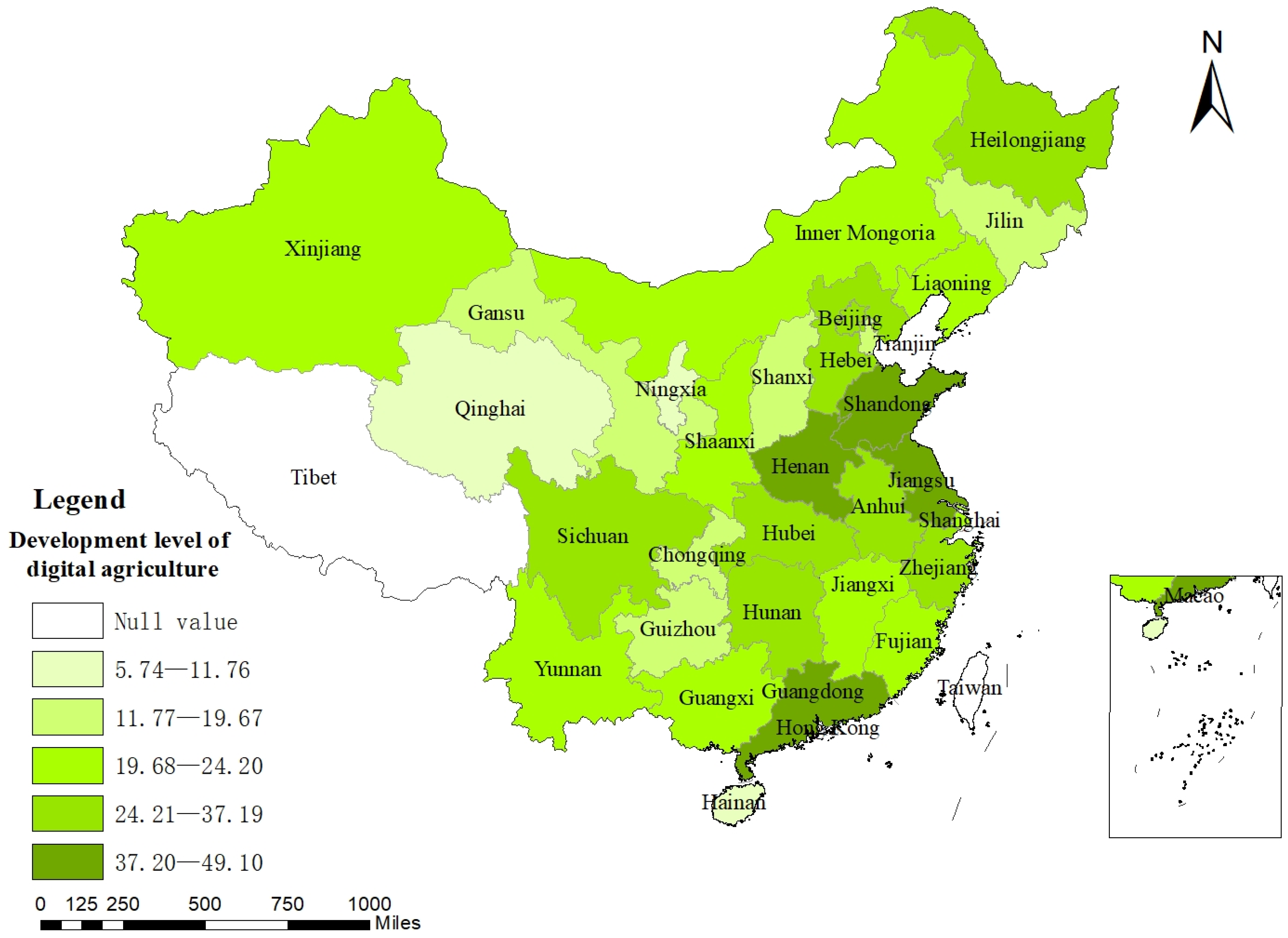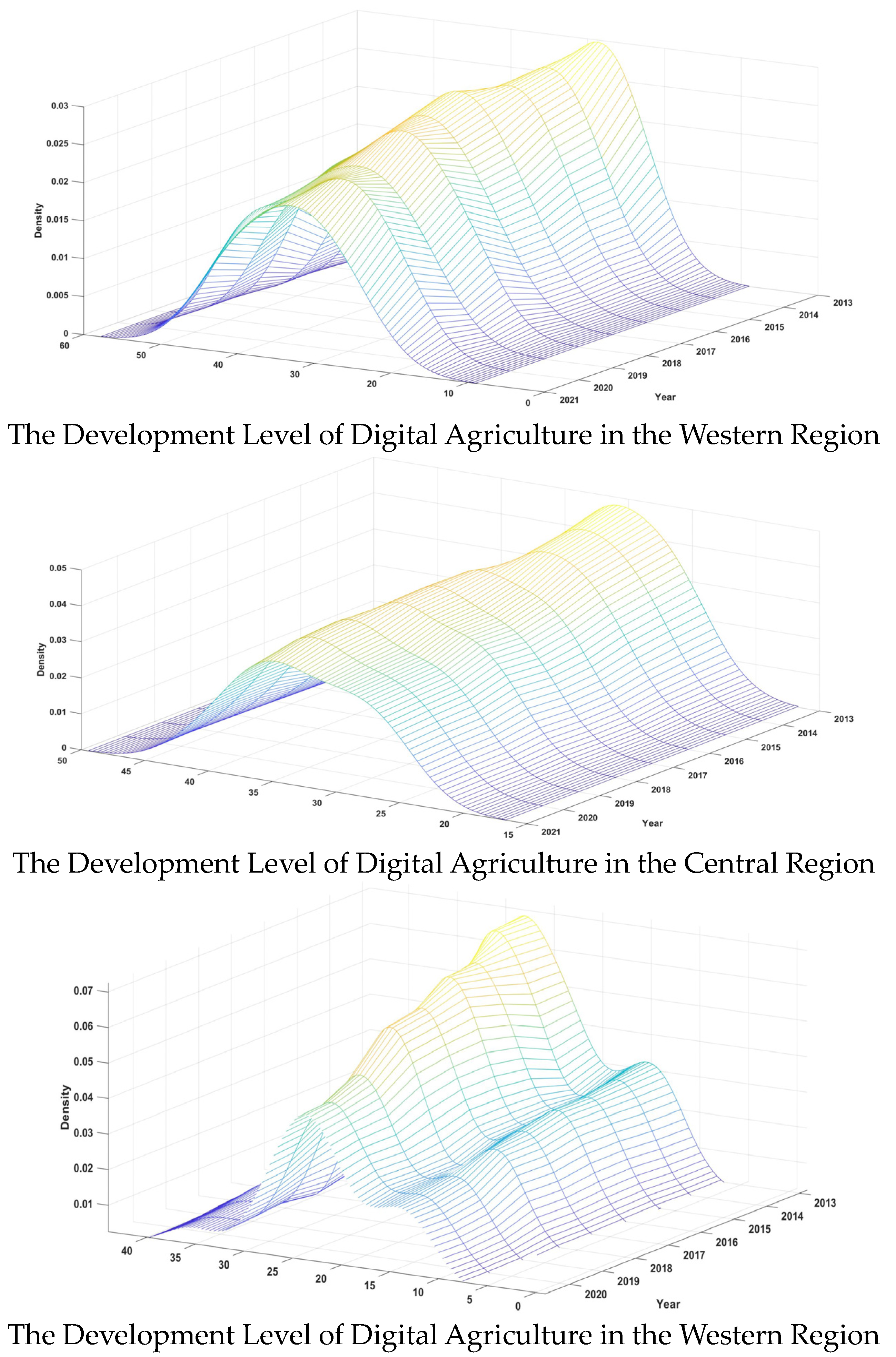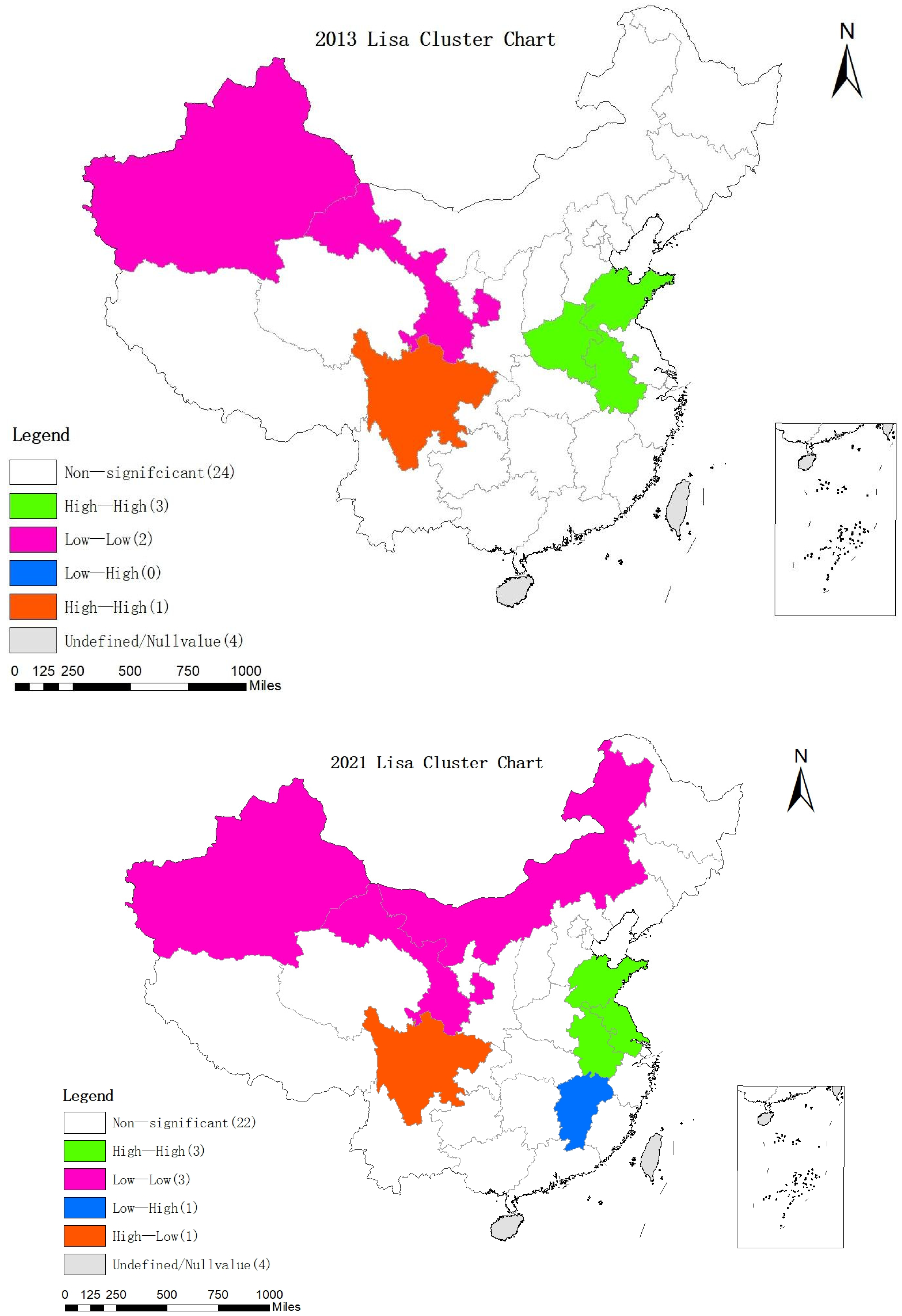2.1. Index System of Digital Agriculture Development Level
The progression of digital agriculture development is intricate, and a solitary indicator falls short of providing an objective evaluation. Consequently, most scholars rely on the construction of an index system to gauge the development level of digital agriculture [
43,
44,
45]. In this paper, we have formulated an evaluation system based on insights from the “2021 National County Agricultural and Rural Informatization Development Level Evaluation Report, (in China)” and the “Digital Countryside Development Report in China”, as well as other pertinent research reports and studies. This comprehensive system comprises five core dimensions and encompasses 18 key indicators, which include digital agriculture infrastructure, digital agriculture talent, the agricultural informatization level, the digitization of the agricultural production process, and the agricultural production efficiency, as shown in
Table 1.
Infrastructure forms the bedrock for digital agriculture development, which encompasses five crucial aspects: rural delivery routes, total reservoir capacity, road mileage, rural electricity consumption, and the length of optical fiber cables. Rural delivery routes and road mileage represent the transportation infrastructure essential for the movement of agricultural production materials and products. Meanwhile, total reservoir capacity and rural electricity consumption are fundamental resources vital for digitizing the agricultural production process. The length of optical fiber cables serves as the hardware foundation underpinning the advancement of agricultural informatization and digitization.
Talent resources play an indispensable role in elevating the level of digital agriculture development. In comparison to hardware infrastructure, the scarcity of human resources remains a primary challenge in the digital agriculture development process and stands as a pivotal indicator reflecting the current state of digital agriculture development. Talent resources within digital agriculture are evaluated through four key indicators: average years of education in rural areas, education expenditure, science and technology expenditure, and the average number of students enrolled in higher education per 100,000 population.
The level of agricultural informatization is a critical dimension that mirrors the state of digital agriculture development. The application of digital technology has made data and information pivotal in agricultural progress. Evaluation indicators for the level of agricultural informatization encompass the density of cell phone base stations, the number of Internet domain names per 1000 people, and the count of rural broadband access users.
The digitization of the agricultural production process represents a key facet of digital agriculture development. The essential roles of digital agriculture are to refine the production process, enhance agricultural production efficiency, and conserve resources. This dimension includes indicators such as the effective irrigated area, the total power of agricultural machinery, and the number of large and medium-sized tractors used in agriculture. These indicators provide insights into the capacity and degree of digitization of the production process in various regions.
The agricultural production efficiency serves as the ultimate objective of digital agriculture development. Vigorously promoting the digital agriculture process aims to achieve high-quality agricultural development and sustainability, with the ultimate benefits reflected in the efficiency of agricultural production. This dimension includes indicators such as e-commerce sales, per capita disposable income of rural households, and the total output value of agriculture, forestry, animal husbandry, and fisheries.
2.2. Methods of Measuring the Development Level of Digital Agriculture
In the contemporary landscape of digital agriculture development assessment, traditional methods such as the entropy value method and principal component analysis are widely employed. However, these conventional approaches tend to underemphasize the inherent significance of individual indicators. In light of this, this paper adopts a novel weighted analysis technique that integrates the dynamic evolution and sequential relationships of indicators, referred to as objective sequential analysis (SRA). SRA represents a weighted analysis approach that intricately blends the dynamic evolution and sequential relationships among indicators. This method places heightened importance on discerning the relative significance of indicators within the evaluation framework. It achieves this by scrutinizing the variations in indicators across different evaluation periods, thereby objectively ascertaining their weights within the evaluation system.
Consider a scenario where there are alternatives, denoted as , measured by indicators, marked as . Without a loss of generality, let represent the actual performance of alternative on indicator in assessment period , where represents periods. In the objective sequential analysis (SRA) method, the comparative evaluation of indicators is quantified based on their competitive capability, rather than relying on subjective judgments from experts. Consequently, the initial step in this process involves determining the competitive capabilities of different indicators by analyzing the positive shifts in their ranking values.
Let
represents the competitive capability of indicator
, then:
where
indicates the ranking value of alternative
out of all the alternatives on indicator
in period
, with the values ranged in
.
is a counting function used to count the number of sort improvements in the next period over the adjacent previous period of alternative
on indicator
.
It is known that . Therefore, . A larger value of indicates the higher competitive capability of indicator .
Based on the analysis above, the objective SRA method is proposed as follows:
Step 1—Rearrange indicators by their competitive capability.
Rearrange the indicators by their competitive capability . An indicator with a higher competitive capability (larger value of ) ranks on the top of the ordered indicators. For simplicity, we denote the ordered indicators as , where “” represents “proceed”.
Step 2—Determine the ratio of the importance of two adjacent indicators.
The ratio of importance of two adjacent indicators
and
, denoted as
, can be determined by:
Step 3—Calculate the indicator weights
Let variable
be the weight of indicator
. Then, we have:
The validity of Equation (3) is proved in the following.
Proof. Since for , we have .
Then, .
Therefore, .
Since , we have .
The equation can be deduced from . □
Once the weights for each indicator have been determined, the next step involves calculating the evaluation values for the five dimensions: digital agriculture infrastructure, digital agriculture talent resources, the agricultural informatization level, the digitization of the agricultural production process, and agricultural production efficiency. These evaluation values for each dimension are represented as
,
,
,
, and
, and the level of digital agriculture development is represented by
. Where
represents provinces and
represents indicators, the specific formula expressions are as follows:
In order to ensure the dynamic changes in different evaluation periods, the data are standardized using the method of dynamic extreme value. As all the indicators in the evaluation index system of digital agriculture development level are positive indicators, their processed values are set as
, and the formula is as shown in Equation (10):
2.3. Methods for Assessing Spatial and Temporal Trends in the Development Level of Digital Agriculture
(1) Distribution pattern—Kernel density estimation.
Kernel density estimation is one of the methods of spatial disequilibrium analysis. The position of the kernel density curve is utilized to reflect the level of digital agriculture development. We utilize the height and width of wave peaks to illustrate the degree of discrete agglomeration. The number of wave peaks is used to illustrate the polarization phenomenon, and the ductility-dragging tail phenomenon is used to illustrate the degree of divergence.
It is assumed that the density function of the random variable
of the method is as follows:
where
is the number of observations;
is the bandwidth;
is the kernel density;
is the independent identically distributed observations; and
is the mean value. In addition, it is necessary to satisfy:
;
;
;
;
.
(2) Spatial autocorrelation—Moran index and Lisa plot.
Whether the digital agriculture development level has spatial autocorrelation needs to be tested by autocorrelation. Global spatial autocorrelation is mainly used to measure whether there are agglomeration characteristics of spatial units, while local spatial autocorrelation explains the agglomeration characteristics of specific spatial locations and the significance of agglomeration, which is presented by Lisa diagrams. The global Moran’s
I and local Moran’s
I are specifically represented as follows:
where
is the number of spatial units,
and
are the attribute values of the ith and jth spatial units,
is the spatial weight value, using spatial neighbor weights, and
is the average of the attribute values of all spatial units.
(3) Evolutionary dynamics—Markov chains.
Markov chains are utilized to illustrate the transfer probabilities of the digital agriculture development level at different states. The Markov chain is a
matrix of transfer probabilities depicting the transfer of attribute types at different times, with the probability of a region of type
at time t transferring to type
at the next moment denoted by
:
Assuming that the Markov transfer probabilities are smooth in time, we have the following:
where
denotes the number of areas transferred from type
to type
in the study time period, from time period t to the next time period, and
denotes the number of areas of type
in time period
.
is the
sth power of the transfer probability matrix
, and
,
are the probability distributions over time periods
and
, respectively.
While the spatial Markov chain method is formed by introducing spatial autocorrelation into the Markov chain method, the transfer probability matrix is conditioned on the type of spatial lag in a region at time
. The spatial lag value of region
is a weighted average of the values of attributes of spatially neighboring regions of the region, which is given in the following formula:
where the spatial weight matrix
denotes the spatial relationship between region
and region
using the spatial adjacency matrix,
denotes the attribute value of region
, and
is the spatial lag value of region
, which denotes the state of the region
neighborhood.











